开窍要诀英文五大基本句型SentencesPatterns开窍要诀英文五大基本句型句型幻灯片课件
- 格式:ppt
- 大小:261.50 KB
- 文档页数:12
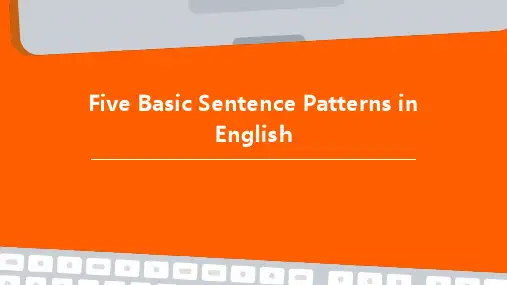

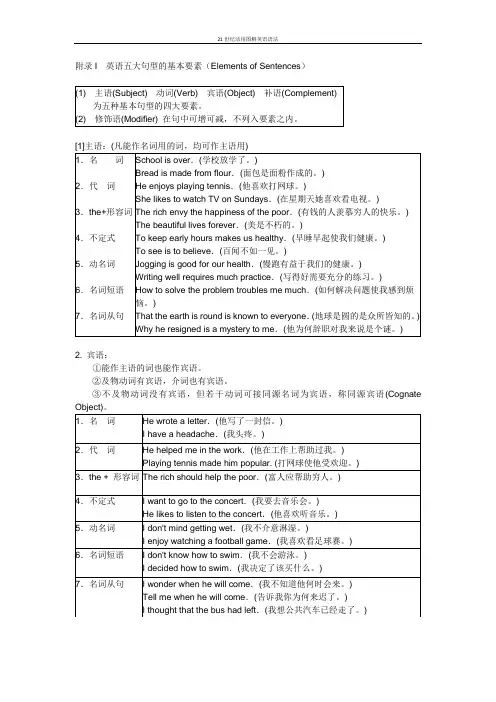
附录I 英语五大句型的基本要素(Elements of Sentences)
2. 宾语:
①能作主语的词也能作宾语。
②及物动词有宾语,介词也有宾语。
③不及物动词没有宾语,但若干动词可接同源名词为宾语,称同源宾语(Cognate
3. 补语:(用于补充说明主语或宾语者)
4. 修饰语:①用于修饰主语、宾语或补语之形容词或形容词相等语。
②用于修饰动词之副词或副词相等语。
(A) 作形容词
附录II “Subject + be + to V”句型解析
附录III “Be+不及物动词之过去分词”
“Be+及物动词之过去分词”固然是表示被动语态,如:He was killed. (他被杀了)。
但“Be+不及物动词之过去分词”,则不是被动语态,而是用来表达“完成式”在动作结果后所留下的状
(a)句“h a s gone'‟是译成“已经走了”,(b)句……is gone'‟则类似中国人常常说的“早就已经走了”。
故在冬天雪开始溶化时我们会说Spring has come.(春临大地),但如果是到了大地一片鸟语花香、小姑衣薄时,我们便会说Spring is come.(春满人间)。
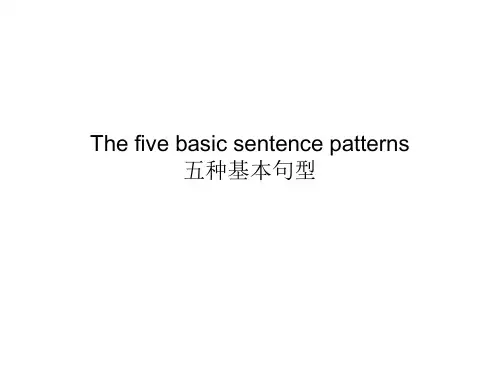
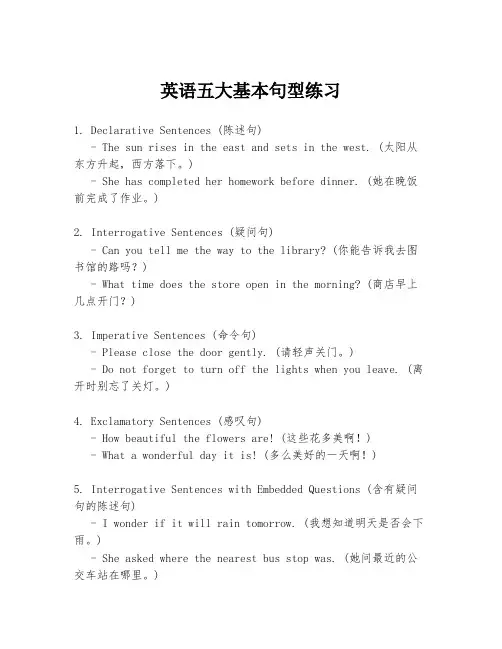
英语五大基本句型练习1. Declarative Sentences (陈述句)- The sun rises in the east and sets in the west. (太阳从东方升起,西方落下。
)- She has completed her homework before dinner. (她在晚饭前完成了作业。
)2. Interrogative Sentences (疑问句)- Can you tell me the way to the library? (你能告诉我去图书馆的路吗?)- What time does the store open in the morning? (商店早上几点开门?)3. Imperative Sentences (命令句)- Please close the door gently. (请轻声关门。
)- Do not forget to turn off the lights when you leave. (离开时别忘了关灯。
)4. Exclamatory Sentences (感叹句)- How beautiful the flowers are! (这些花多美啊!)- What a wonderful day it is! (多么美好的一天啊!)5. Interrogative Sentences with Embedded Questions (含有疑问句的陈述句)- I wonder if it will rain tomorrow. (我想知道明天是否会下雨。
)- She asked where the nearest bus stop was. (她问最近的公交车站在哪里。
)。
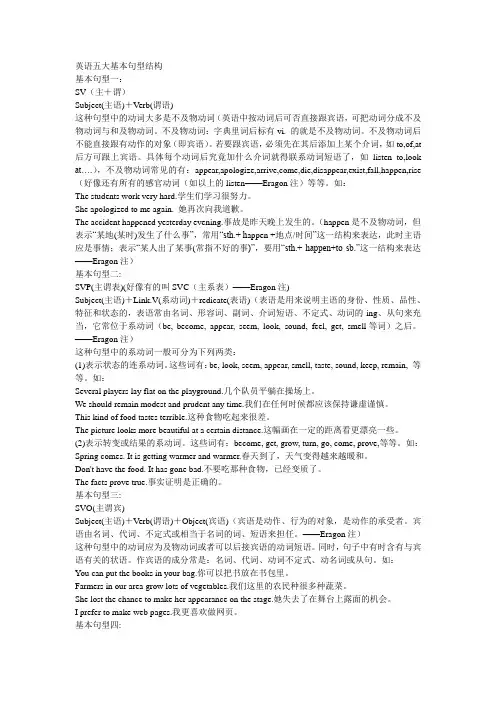
英语五大基本句型结构基本句型一:SV(主+谓)Subject(主语)+Verb(谓语)这种句型中的动词大多是不及物动词(英语中按动词后可否直接跟宾语,可把动词分成不及物动词与和及物动词。
不及物动词:字典里词后标有vi. 的就是不及物动词。
不及物动词后不能直接跟有动作的对象(即宾语)。
若要跟宾语,必须先在其后添加上某个介词,如to,of,at 后方可跟上宾语。
具体每个动词后究竟加什么介词就得联系动词短语了,如listen to,look at….),不及物动词常见的有:appear,apologize,arrive,come,die,disappear,exist,fall,happen,rise (好像还有所有的感官动词(如以上的listen——Eragon注)等等。
如:The students work very hard.学生们学习很努力。
She apologized to me again. 她再次向我道歉。
The accident happened yesterday evening.事故是昨天晚上发生的。
(happen是不及物动词,但表示“某地(某时)发生了什么事”,常用“sth.+ h appen +地点/时间”这一结构来表达,此时主语应是事情;表示“某人出了某事(常指不好的事)”,要用“sth.+ happen+to sb.”这一结构来表达——Eragon注)基本句型二:SVP(主谓表)(好像有的叫SVC(主系表)——Eragon注)Subject(主语)+Link.V(系动词)+redicate(表语)(表语是用来说明主语的身份、性质、品性、特征和状态的,表语常由名词、形容词、副词、介词短语、不定式、动词的-ing、从句来充当,它常位于系动词(be, become, appear, seem, look, sound, feel, get, smell等词)之后。
——Eragon注)这种句型中的系动词一般可分为下列两类:(1)表示状态的连系动词。
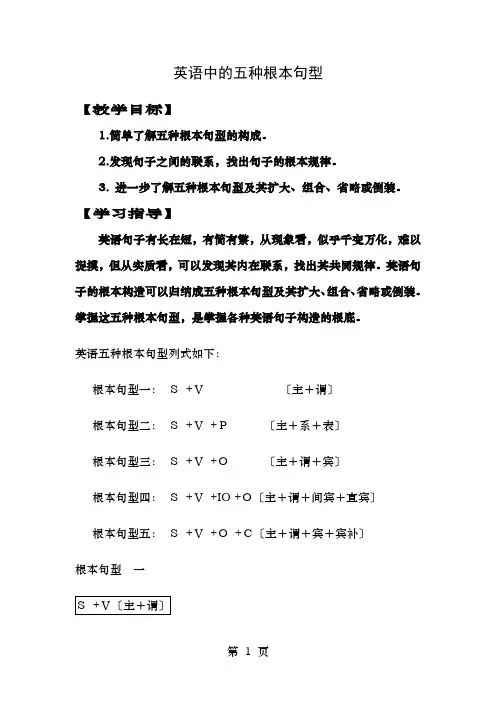
英语中的五种根本句型【教学目标】1.简单了解五种根本句型的构成。
2.发现句子之间的联系,找出句子的根本规律。
3. 进一步了解五种根本句型及其扩大、组合、省略或倒装。
【学习指导】英语句子有长在短,有简有繁,从现象看,似乎千变万化,难以捉摸,但从实质看,可以发现其内在联系,找出其共同规律。
英语句子的根本构造可以归纳成五种根本句型及其扩大、组合、省略或倒装。
掌握这五种根本句型,是掌握各种英语句子构造的根底。
英语五种根本句型列式如下:根本句型一:S+V〔主+谓〕根本句型二:S+V+P〔主+系+表〕根本句型三:S+V+O〔主+谓+宾〕根本句型四:S+V+IO +O〔主+谓+间宾+直宾〕根本句型五:S+V+O+C〔主+谓+宾+宾补〕根本句型一此句型的句子有一个共同特点,即句子的谓语动词都能表达完整的意思。
这类动词叫做不及物动词,后面可以跟副词、介词短语、状语从句等。
根本句型二此句型的句子有一个共同的特点:句子谓语动词都不能表达一个完整的意思,必须加上一个说明主语身份或状态的表语构成复合谓语,才能表达完整的意思。
这类动词叫做连系动词。
系动词分两类:be, look, feel,smell,taste,sound等属一类,表示情况;get, grow, become, turn,go等属另一类,表示变化。
be 本身没有什么意义,只起连系主语与表的作用。
其它系动词仍保持其局部词义另:stay,prove,remain,stand根本句型三S+V+O〔主+谓+宾〕此句型句子的共同特点是:谓语动词都具有实义,都是主语产生的动作,但不能表达完整的意思,必须跟有一个宾语,即动作的承受者,才能使意思完整。
这类动词叫做及物动词。
根本句型四此句型的句子有一个共同特点:谓语动词必须跟有两个宾语才能表达完整的意思。
这两个宾语一个是动作的直接承受者,另一个是动作的间接承受者。
通常这一间接承受者用一个介词来连接,当动作的间接承受者在动作的直接承受者之前时,这一介词往往被省略。
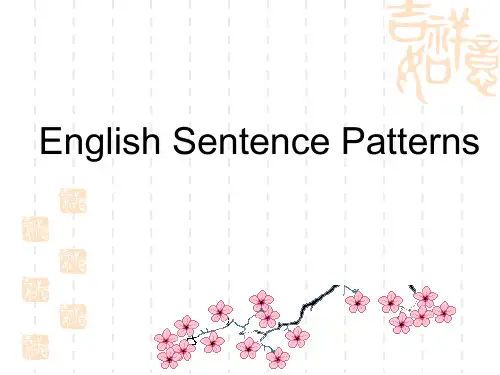
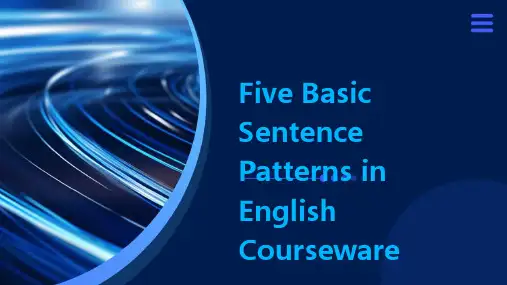
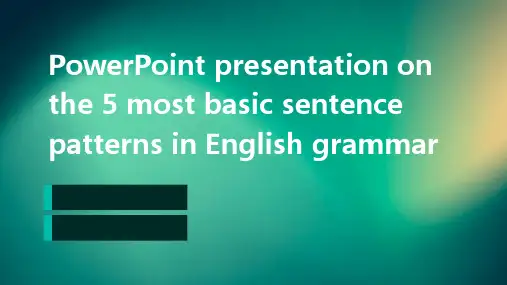
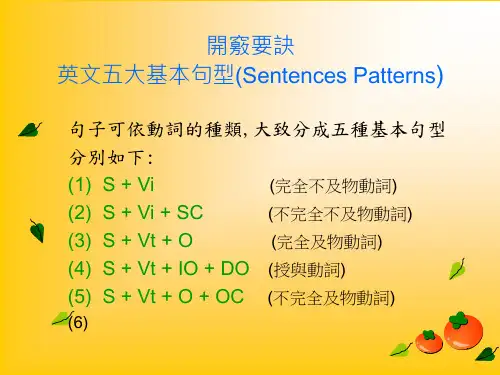
英语五大句型口诀
2019-11-21 15:02:04
文/叶丹
英语五大句型口诀:英语句万万千,五大句型把线牵。
句型种类为动词,后接什么是关键;系词后面接表语;vi独身无牵连;vt又可分三类,单宾双宾最常见,还有宾语补足语;各种搭配记心间。
英语简单句型及例子
主+谓(不及物动词)S+V eg:the birds are f lying
主+谓(及物动词)+宾 S+V+O eg.dogs like bones
主+谓(及物动词)+宾+宾补 S+V+O+OC he makes me laugh 主+谓(及物动词)+间宾+直宾S+V+DO+IO eg:mum bought me a book
主+谓(联系动词)+表语S+V+P eg:the flower looks beautiful
五种基本句型
1.主语+系动词+表语
2.主语+不及物动词
3.主语+及物动词+宾语
4.主语+及物动词+宾语+宾语补足语
5.主语+及物动词+宾语1+宾语2。
五种基本句型的英文作文英文回答:There are five basic sentence patterns in English. These patterns are used to construct sentences and convey different types of information. Let me explain each pattern and provide examples for better understanding.1. Subject + Verb (S + V)。
This is the most basic sentence pattern in English. It consists of a subject (a noun or pronoun) and a verb. For example:I swim. (我游泳。
)。
She sings. (她唱歌。
)。
2. Subject + Verb + Object (S + V + O)。
In this pattern, the subject performs an action on an object. For example:He eats an apple. (他吃一个苹果。
)。
They watch a movie. (他们看电影。
)。
3. Subject + Verb + Complement (S + V + C)。
A complement provides more information about the subject or the object. It can be an adjective, a noun, or a pronoun. For example:She is happy. (她很开心。
)。
They became doctors. (他们成为医生。
)。
4. Subject + Verb + Indirect Object + Direct Object (S + V + IO + DO)。
英语五大基本句型IntroductionIn English language, there are five basic sentence patterns that students need to learn. These sentence patterns are simple, compound, complex, compound-complex, and declarative sentences. Knowing these sentence patterns is essential in mastering English grammar, as they form the foundation of sentence structure. In this essay, we will explore each of these sentence patterns in detail.Simple SentencesSimple sentences contain a single independent clause, which means it has a subject and a verb and expresses a complete thought. Simple sentences are usually short and straightforward, making them the easiest type of sentence to understand. Examples:1. I woke up early this morning.2. She loves playing the piano.3. Dogs bark.4. The sun sets in the west.5. He ate sushi for dinner.Compound SentencesA compound sentence consists of two or more independent clauses joined by a coordinating conjunction like and, but, or, so, yet. The independent clauses in a compound sentence should be closely related in meaning and equal in importance. A comma is usually placed before the coordinating conjunction. Examples:1. I want to go to the beach, but it's raining outside.2. She loves dancing, and she's very good at it.3. He prepared his presentation, so he felt confident at the meeting.4. She was tired from work, yet she went to the gym anyway.5. He went to the store, and he bought some milk and bread.Complex SentencesComplex sentences contain one independent clause and one or more dependent clauses. The dependent clause usually starts with a subordinating conjunction like although, because, if, since, while. The dependent clause cannot stand alone as a complete sentence. Examples:1. Although I studied hard, I failed the test.2. Because it was raining, I stayed inside all day.3. If you don't eat breakfast, you will feel hungry later.4. Since he left early, we couldn't finish the project on time.5. While I was walking the dog, I saw a squirrel in the park.Compound-Complex SentencesA compound-complex sentence is a combination of a compound sentence and a complex sentence. It contains two or more independent clauses and one or more dependent clauses. It is the most complex type of sentence and can be challenging to understand. Examples:1. She went to the store, and she bought some milk and bread, although she didn't need them.2. I woke up early this morning because I had a lot to do, and I knew I needed extra time, although I still felt tired.3. Although it was raining, I went for a walk, and I enjoyed the fresh air even though I got wet.4. He practiced hard for the game, but he still felt nervous since it was his first time playing in front of a large crowd.5. I wanted to go to the party, yet I knew I had to study for my exam because I didn't want to fail.Declarative SentencesA declarative sentence is a sentence that makes a statement or declares something. It ends with a period. Declarative sentences can be any type of sentence pattern, including simple, compound, complex, or compound-complex. Examples:1. The sky is blue.2. I am going to the store.3. She will be late for the meeting because of traffic.4. He loves to read books and watch movies.5. Although it was hot outside, we still had a great time at the beach.ConclusionIn conclusion, understanding the basic sentence patterns in English is essential for effective communication. Simple sentences are easy to understand, but compound and complex sentences require more attention. Compound-complex sentences are the most complex type of sentence and can be challenging to understand. Declarative sentences can be any type of sentence pattern, and they make a statement or declare something. By mastering these basic sentence patterns, students can improve their writing and speaking skills, and communicate more effectively in English.。
怎么快速学会英语中五种基本句型?谢谢头条邀请。
如何快速学会英语的五种基本句型,这个问题真没有想象中的那么难。
⾄于何为五种基本句型,暂时就不在这⾥⽤多余的篇幅加以解释,想必问的⼈已经知道是哪五种,更多的是求⼀种速学⽅法吧。
对五种基本句型有疑问的⼈,可以直接上⽹查找或者翻看你们的英语笔记,现在就来讲讲怎么学会这五种句型。
学习英语句型的本质是什么?就单独拿英语来说,时常会出现某某句型,然后⽼师再讲解此句型如何运⽤,有哪些知识点。
句型就相当于⼀个个固定的模块,你把要表述的句⼦,扔到模块当中去套⽤。
熟练掌握句型的⼈,可以快速从脑海中提取对应的模块进⾏使⽤,这就是举⼀反三。
⽽对句型不熟练的⼈,明⽩⽼师讲的知识点后,换个句⼦,马上就茫然,这就是⽕候不到家的表现。
句型的本质是什么?个⼈认为不过是为了让你更好的理解⼀句话的组成成分,总结出语⾔的规律,让你知其然也知其所以然。
然⽽,我们太过注重知其所以然,变得死抠句型,死死要记住N多种句型,以为记住了就能掌握英语⼀般,然则⼤错特错。
学习语⾔该不该敢弄明⽩这五种基本句型?答案是肯定的。
但学习⽅法与本质绝不是让你去研究所谓的各类繁多句型。
语⾔⽆⾮存在⼆点技巧,⼀个是输⼊,⼀个是输出。
没有输⼊,根本就输出不了。
语⾔的学习不需要有多⾼的智商,只要⼀个死磨硬泡的⼼。
哪怕是机械性的输⼊语⾔,也可以达到掌握英语的⽔准。
所以不要怕英语想得太难。
现在直切重点,下⾯开始讲⽅法论。
怎么学句型?与其说是如何学习句型,倒不如更准确地说是如何学习语⾔,因为本质是完全相同的。
⽅法就是不断的背诵与朗读。
很多⼈会特别在意所谓的理解后再去记忆,其实也未尝不可。
语⾔最本源的⽅法该是⼤量的输⼊。
朗读可以加强语感,背诵可以形成思维积累。
看到⼀个句⼦时,错误的思考⽅式是先思考是何句型,运⽤什么时态,我该套⽤哪个公式。
这是典型的中国式学⽣英语思维,完全与语⾔的本质背道⽽驰。
学霸的⽅式为:看⼀眼直接根据脑海⾥第⼀反应,条件反射写下对应的句⼦。
英语句子看上去纷繁庞杂,但仔细观察不外乎五个基本句式。
这五个基本句式可以演变出多种复杂的英语句子。
换言之,绝大多数英语句子都是由这五个基本句式生成的。
这五个基本句式如下:S十V主谓结构S十V十P主系表结构S十V十O主谓宾结构S十V十O1十O2 主谓双宾结构S十V十O十C 主谓宾补结构说明:S=主语;V=谓语;P=表语;O=宾语;O1=间接宾语;O2=直接宾语;C=宾语补足语五个基本句式详细解释如下:1.S十V句式在此句式中,V是不及物动词,又叫自动词(vi.)。
例如:He runs quickly.他跑得快。
They listened carefully.他们听得很仔细。
He suffered from cold and hunger.他挨冻受饿。
China belongs to the third world country.中国属于第三世界国家。
The gas has given out.煤气用完了。
My ink has run out.我的钢笔水用完了。
2.S十V十P句式在此句式中,V是系动词(link v.),常见的系动词有:look,seem,appear,sound,feel,taste,smell,grow,get,fall ill/asleep,stand/sit still,become,turn等。
例如:He is older than he looks.他比看上去要老。
He seen interested in the book.他似乎对这本书感兴趣。
The story sounds interesting.这个故事听起来有趣。
The desk feels hard.书桌摸起来很硬。
The cake tastes nice.饼尝起来很香。
The flowers smell sweet and nicc.花闻起来香甜。
Y ou have grown taller than before.你长得比以前高了。